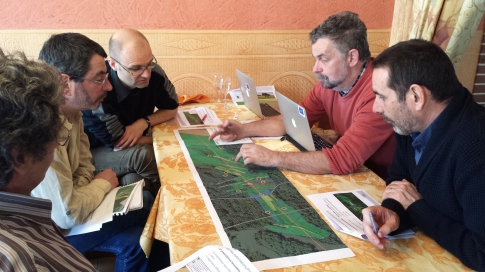News
2015-03-09
Preparing for grazing in ForÍt d'Orient (F)
The Forêt d'Orient site is among the seven French sites of the LIFE Elia-RTE. Located in the Department of Aube (10), in Champagne-Ardenne, this site is about to be managed by a local shepherd.
Meeting indoors and map scouting
The dynamism of our local partners greatly facilitates field operations. We gathered in Brienne-la-Vieille on March 9th 2015 in order to check the actions to be carried out, with local correspondents RTE, a representative of the Regional Natural Park of the Forêt d'Orient and local shepherd.
Private owners concerned by the high-tension line section were first contacted by mail. In the overall, we received enough positive responses to ensure a sufficient area for sheep grazing, but the issue of landownership remains a major challenge in areas where ownership is highly fragmented. Both for Elia in Belgium and RTE in France, the legal possibilities to establish management other than conventional rotary milling without having to obtain the agreement of the owners are studied.

Field trip: grazing prospecting
The afternoon was dedicated to a field visit to verify the feasibility of grazing. The advantage of the latter is that it limits the growth of vegetation and thus ensure maximum electrical safety. Green light from the breeder, despite some regrowth of blood dogwood, blackthorn, oak or poplar. It will be necessary to assess of what has been grazed at the end of the first season. Grazing will be performed with around twenty sheep which will spend about eight days in three different enclosures, delimited by a mobile fence.
For the Nature festival to come (May 2015), these sheep will also have an educational value as visits will be organized to show to school pupils and the general public how electricity is now transmitted along the grid. A didactic panel will be inaugurated and a leaflet will also be published.

And also other actions
In a steeper area of the electrical corridor, forest edges will be restored from the plant species naturally present on site. In the first years, it will be necessary to cut the "problematic" species (species whose final height is threatening electrical cables such as birch, oak, poplar), thus promoting biodiversity-friendly species and whose final height poses no problem (dogwood, blackthorn, willow ...).

Some spots of Black locust were also detected. Grazing will hopefully eliminate this invasive plant.


